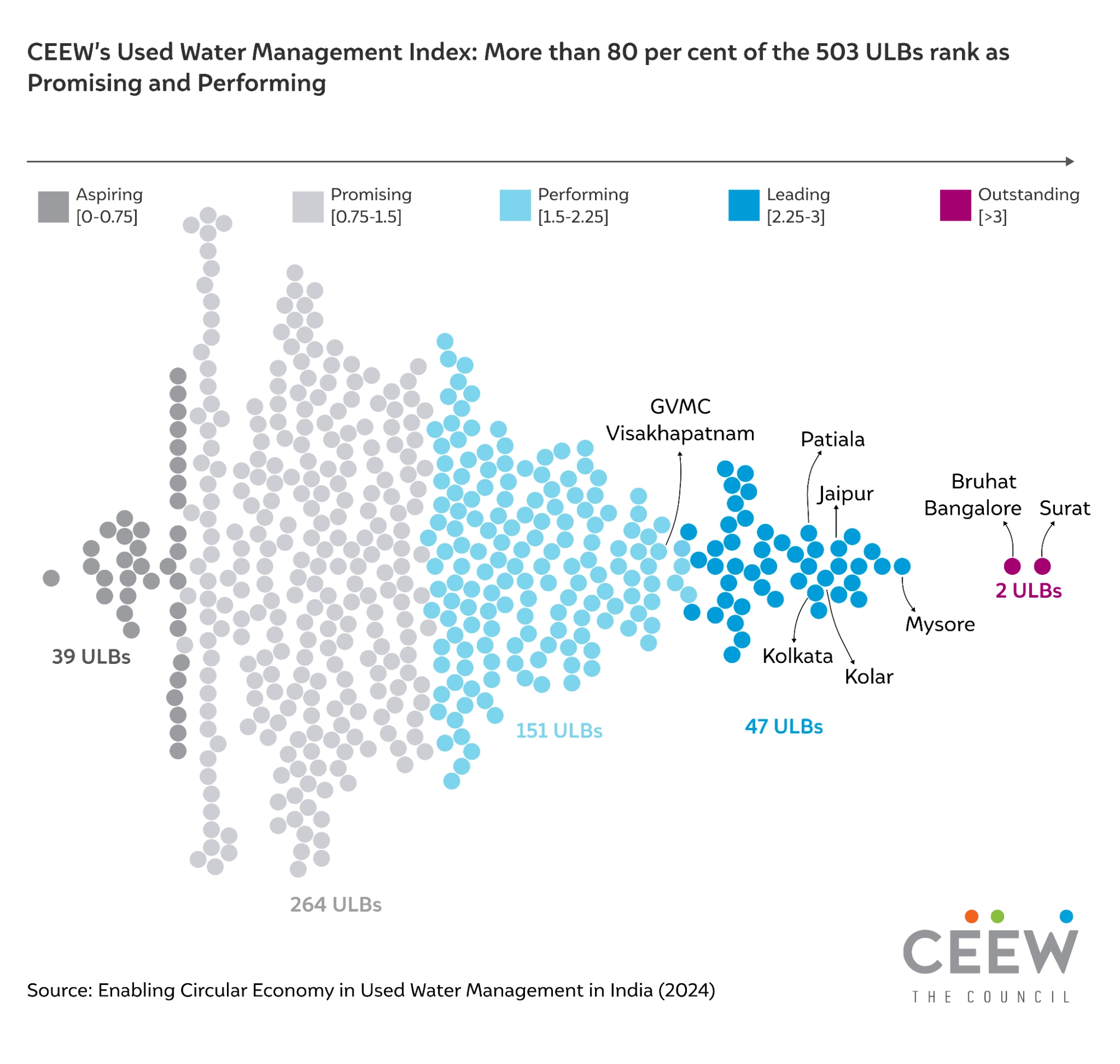



– The study indexes 503 urban local bodies from 10 states with a treated used water reuse policy
– Western, north-western states and Karnataka lead, with eastern states catching up
– 90% ULBs, however, need targeted financial planning & investments for used water management
New Delhi, 12 March 2024: Haryana, Karnataka, and Punjab are the frontrunners of used water management in India, according to a new, independent report by the Council on Energy, Environment and Water (CEEW) released today. With rising urban water demand and dwindling groundwater tables, urban local bodies (ULBs) across the country need to scale up the treatment and reuse of used water for non-potable purposes. However, a lack of targeted financial planning and investments for used water management currently remains a key barrier across 90 per cent of the ULBs, finds the report.
Only 28 per cent of India's 72,000 million litres of used water is treated, as per 2021 data. To strengthen used water treatment and scale up its reuse, there is a need to identify areas that need to be prioritised. Therefore, the CEEW report introduces the first-of-its-kind Municipal Used Water Management (MUWM) Index, focusing on 503 Urban Local Bodies (ULBs) across 10 states—Andhra Pradesh, Chhattisgarh, Gujarat, Haryana, Jharkhand, Karnataka, Madhya Pradesh, Punjab, Rajasthan, and West Bengal—that have adopted treated used water reuse policies. The index ranks them comparatively based on five themes: Finance, infrastructure, efficiency, governance, and data and information. The resulting composite scores categorise ULBs into Aspiring, Promising, Performing, Leading, and Outstanding categories.
At the top end, Surat Municipal Corporation and Bruhat Bengaluru Mahanagara Palike emerge as ‘Outstanding’ performers in the CEEW index, with dedicated action plans for used water management and good performance in areas such as infrastructure and efficiency. At the state level, the report identifies Haryana and Karnataka as leading states, with comprehensive graded action plans, with Punjab and Rajasthan following closely. However, states in eastern India are catching up, with significant progress observed in Jharkhand and West Bengal. The CEEW findings also reveal that the majority of the ULBs needed to adopt a more comprehensive approach to used water management as 60 per cent of ULBs lie in the bottom half of the index, falling under the ‘Aspiring’ and ‘Promising’ categories.
Nitin Bassi, Senior Programme Lead, CEEW, said, “Many Indian cities are now water-stressed. For instance, Bengaluru, which draws most of its freshwater from the Kaveri River and borewells, is currently facing a severe water crisis. Incidents like these in India’s rapidly urbanising regions show the environmental and economic potential of treating and reusing used water for non-potable purposes. Though Karnataka emerges as a frontrunner, it is critical to note that there is a long road to go with no state achieving full scores—the highest being 3.32 out of a maximum of 5. As Bengaluru runs out of freshwater, reusing used water to its full potential for non-potable purposes will be key in the future. Treated used water has a tremendous market potential—about USD 8 million per day in 2021 alone. The CEEW index provides a crucial baseline for ULBs to prioritise their water action, see the gaps they need to fill and realise this notional market and environmental value.”

The CEEW report further highlights finance as a key concern in used water management. Surat in Gujarat stands out with the top score in finance having adopted different public–private partnership (PPP) models, such as the end-user investment model, to achieve economies of scale and effective risk sharing. Moreover, 78 per cent of ULBs require better governance measures to ensure treatment and reuse of used water. Here, Jaipur emerges as the top-scoring ULB, with its latest city master plan (2025) including sewage-related targets on infrastructural requirements and collection efficiency of the sewerage network.

Saiba Gupta, Programme Associate, CEEW, said, “The reuse of treated used water is yet to be mainstreamed in Indian cities. As per our analysis, the adoption of a dedicated reuse plan with clear targets and priority areas for reuse at the ULB level is key for improving used water management. A financially feasible reuse model is also essential for ULBs to cover the cost of treatment from revenues generated from implementing reuse projects. This is a vital step towards ensuring water-secure cities.”
In light of these findings, the CEEW study recommends empowering ULBs to adopt long-term reuse plans, enabling the development of a comprehensive database on used water management, leveraging national initiatives for finance, and promoting healthy competition among ULBs to further the goal of mainstreaming used water treatment and reuse in cities.
For media queries contact: Tulshe Agnihotri – [email protected] | +91 9621119643 / +91 7905717812